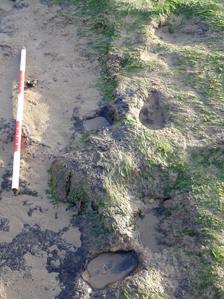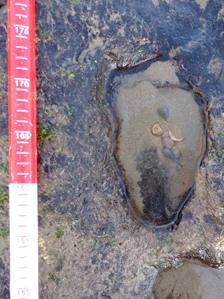Bronze Age footprints found on Port Eynon, Gower, beach
- Published

Five footprints were found after sand was washed from a peat bed
Prehistoric footprints have been discovered on Gower after storms revealed an ancient mud bank.
The five likely Bronze Age footprints were found at Port Eynon beach by Dr Edith Evans, of the Glamorgan-Gwent Archaeological Trust, during a walk.
She said: "They are not the clearest of things but I recognised them straightaway."
Other recent beach storm finds include two cannon in Porthcawl and 10,000-year-old tree remains in Pembrokeshire.
The trust has been monitoring the coast since 2009 after whole tree trunks started to appear in the peat bed which is being eroded by the sea.
Sand which covered the sea bed as a result of erosion was swept away by the storms to uncover the footprints for the first time since they were laid.
The footprints have not been radiocarbon dated but are estimated to be from between 2,300 BC and 700 BC.
Dr Evans said: "There are five prints, probably made by more than one person as they are of two slightly different lengths, and as two of them point towards the sea and the other three point inland.
"The peat has now become so firm that it is impossible to make an impression on it, but when it was first laid down it would have consisted of a soft mass of vegetation.

The footprints were left by at least two people, it is thought
"When the footprints were made, they would have filled up with a deposit of different composition. We assume that the rough seas have washed out this deposit to leave the footprints exposed.
"They were not very clear, one reason being that they were partly covered with sand."
The trust said since 2007 its volunteers have found cattle and pony hoof prints in a peat bed on Kenfig Sands near Sker Point, Bridgend,
Last month, two Georgian-era cannon were found at Pink Bay, Porthcawl, by two dog walkers.
It took a team of around 17 lifeboat crew members, coastguards and local lifeguards to move one of the cannon from the beach.
Also in January, the remains of 10,000-year-old trees were exposed at Newgale, Pembrokeshire.
At the end of the month a ship's wheel which may date back to the 19th Century was uncovered in Swansea Bay.
A member of a heritage group found the wheel while exploring sands near Mumbles.
- Published29 January 2014
- Published13 January 2014
- Published13 January 2014